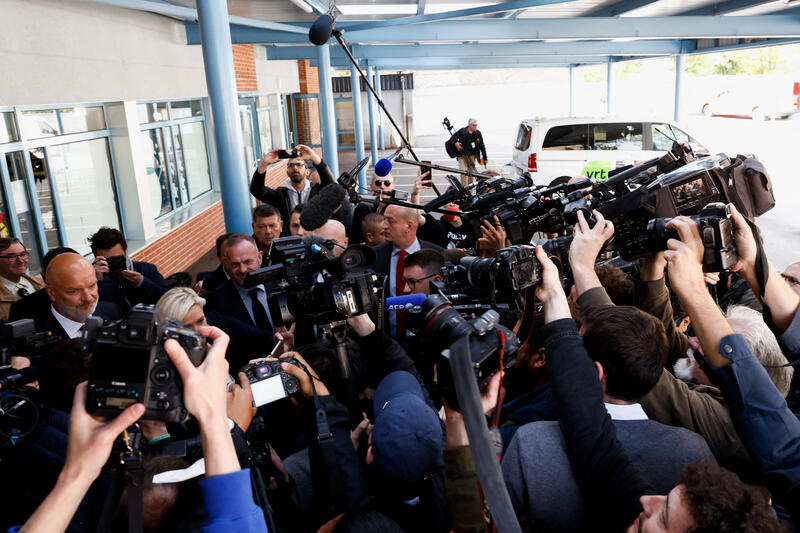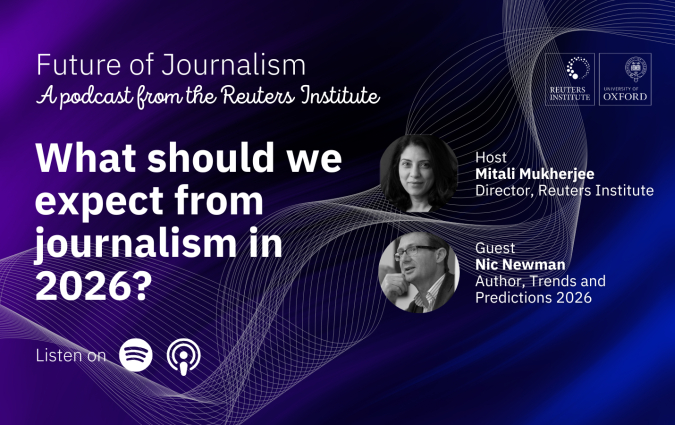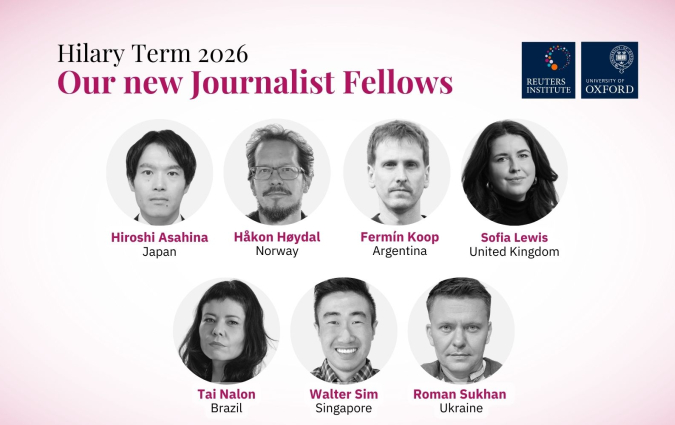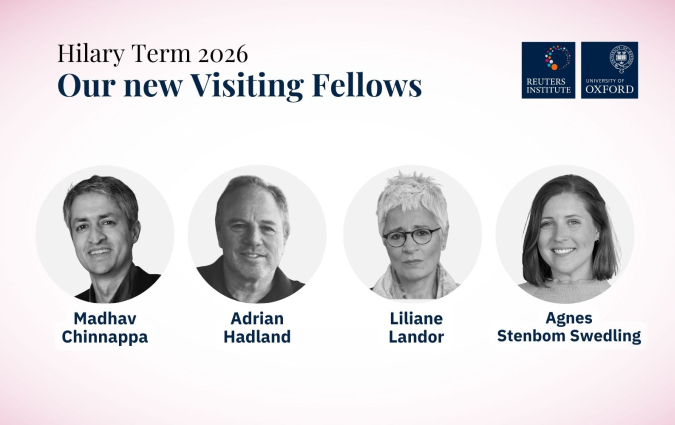Here are the ICA 2022 talks featuring researchers from the Reuters Institute

Marine Le Pen is surrounded by journalists during the 2022 presidential election campaign in France. REUTERS/Darrin Zammit Lupi
The 72nd annual conference of the International Communications Association (ICA) is back as an in-person event in Paris. Here we share the abstracts for the papers that will be presented at the conference taking place 26-30 May. The themes include news avoidance, FOMO, misinformation, polarisation and trust, with evidence from countries around the world.
Beyond reason: rethinking morality in political communication
Both conceptually and empirically, the ways scholars have studied morality in political communication are often limited in scope. Here, I develop a framework for and approach to the study of morality—a concept rarely expressly theorised or developed as an object of analysis—as a strategic and identity-based tool in political communication, catching powerful forms of routine political discourse that are largely missed by existing theories and models. I show how partisan actors have identity-based motivations to employ particular forms of moral political communication: religious, social, and civic morality. Applying this framework to mixed-method content analyses of 2020 U.S. election discourse among opinion media and political campaigners, I reveal the pervasive nature of moral political communication in U.S. spaces of political opinion and campaign discourse, demonstrating how elite political and media actors can draw upon moral language and emotions to both attract and perform for particular identity coalitions.
Political communication > U.S. 2020 election: identity-based political communication and its consequences
Inequities of race, place, and gender among the communication citation elite, 2000-2019
Deen Freelon, Meredith L. Pruden, Kirsten A. Eddy, Rachel Kuo
A recent wave of studies has focused on the identities of communication scholars, quantifying the degree to which whites and males dominate the discipline. This study analyses the communication citation elite (CCE)—a group of over 1,000 of the most-cited scholars in communication research—in terms of race, gender, and country of employment over 20 years. Applying both computational and content analysis methods, we find that 91.6% of CCE members are white, 74.7% are men, and 77.8% work in the United States. Longitudinal analyses of the proportions within these categories reveal only minor shifts, most prominently slight gains for women and scholars working outside the US. White representation decreased only three percentage points over the study period (from 95.6% to 92.4%), with Black representation also ending lower than it began (0.85% to 0.49%).
Ethnicity & race in communication > Communication, race, and its intersections
“It’s a battle you are never going to win”: perspectives from journalists in four countries on how digital media platforms undermine trust in news
Amy A. Ross Arguedas, Sumitra Badrinathan, Camila Mont’Alverne, Benjamin Toff, Richard Fletcher, Rasmus Kleis Nielsen
The growing prominence of platforms in news consumption has raised scholarly concerns about potential impacts on trust in news, which has declined in many countries. However, less is known about how journalists themselves perceive this relationship, which matters for understanding how they use these technologies. In this paper, we draw on 88 interviews with news workers from four countries in both the Global North and South to examine journalists’ narratives—as meta-journalistic discourse—about how platforms impact trust in news. We find that practitioners across all environments express mostly critical ideas about platforms vis-à-vis trust on two different levels. First, they described platforms as disruptive to journalistic practices in ways that strain traditional norms on which trust is based. Second, they discussed platforms as altering the contexts in which journalistic texts and discourses about journalism circulate, weakening the profession’s authority. Despite these reservations, most continue relying on platforms to reach audiences, highlighting the complex choices they must make in an increasingly platform-dominated media environment. As discourses connecting journalistic practice and meaning, these narratives speak to tensions within journalism as a profession around appropriate norms and practices, and challenges to the profession’s claims to authority.
Journalism studies > Cross-national perspectives on trust in journalism
Domain-specific influence on Facebook in Brazil, India, the UK, and US
Camila Mont'Alverne, Amy A. Ross Arguedas, Sumitra Badrinathan, Benjamin Toff, Richard Fletcher, Rasmus Kleis Nielsen
Concerns about misinformation and patterns of exposure to information online have prompted questions about the nature of influence on social media platforms. Prior studies have shown that news is a small fraction of what most people see and interact with online; however, in this study we show how influence on Facebook plays out in domain-specific ways. We draw on a unique dataset of interactions from CrowdTangle, sampling over a six-month period in 2021 across four countries (Brazil, India, the UK, and the US), to assess which kinds of public groups and pages drive interactions with top-trending links shared on Facebook both in general and for three specific subjects: COVID-19, political leaders in each country, and climate change. Our preliminary findings suggest that when it comes to domain-specific political topics, news media accounts (but often not legacy media) remain influential but in ways that are context-sensitive, varying by topic and country.
Political communication > Concerns about platform power: Twitter bans and calls for policy change
International perspectives on information avoidance during the coronavirus pandemic: comparing media evaluations and media use in Pakistan, Germany, and Indonesia
Christina Schumann, Waqas Ejaz, Mira Rochyadi-Reetz, Eni Maryani, Anna Agustina
This study investigates the comparative prevalence of information avoidance concerning the coronavirus and its relationship with media use and evaluation in Pakistan, Indonesia, and Germany. In this paper, we argue that information avoidance is a behaviour that broadly signifies an intermittent and conscious practice to shun specific content. It is problematic behaviour because having an informed citizenry is essential, especially during a global pandemic. Furthermore, based on the existing literature, we assume that media use and its evaluations are associated with information avoidance. Hence, to test our assumptions, we collected data in Germany (n=821), Indonesia (n=1164), and Pakistan (n=467). The results indicate important differences with regards to the prevalence of information avoidance as well as media use and its evaluations across the three countries. Moreover, the analysis further confirms the relationship between media use and its evaluations with information avoidance. However, there are various differences across the three countries, the reasons for which are further discussed.
Intercultural communication > Global impact of COVID-19 on intercultural communication
(In)direct relationships between social media use, perceived benefits, self-esteem, and fear-of-missing-out (FOMO)
Waqas Ejaz, Ghazala Naeem
Social media applications allow users to convey their activities to others and view what others are doing in real-time, consequently inducing distress and negative psychological processes. One such process is called Fear-of-Missing-Out (FoMO), which is rooted in the realisation that you may be missing out on rewarding experiences that others are having. Past research informs that FoMO is conceptualised as "the desire to stay continually connected with what others are doing" and feeling worried that others are having a good time without them. FoMO is may be a function of one’s degree of social media usage, hence, similar to numerous past studies, arguing the direct relationships between the two. However, most of this literature is based on the Global North whereas in this study we are trying to understand if the findings from the previous studies replicate in the Global South - in this case - Pakistan. Also, in the study we employed novel method of combining survey and log data from the respondents to understand their subjective v/s actual social media usage and its association with key constructs psychosocial constructs.
Mobile communication > Mobile media methods, methods, and processes
Leveraging religiosity against COVID-19 misinformation: experimental evidence from India
Sumitra Badrinathan, Simon Chauchard
COVID-19 misinformation dilutes beliefs in science and increases social tensions. How can this misinformation be corrected, especially when it is rooted in long-standing belief systems and group identities? We answer this question with an experiment in India that develops a novel correction strategy (N=1600). Since people with higher levels of religiosity and support for nationalist parties more likely believe covid misinformation, we use verses from religious scriptures exhorting people to believe in the truth, alongside corrections, to reduce the uptake of falsehoods. We demonstrate that this technique is significantly effective at improving information processing, even beyond the specific story corrected. We further show that while targeting religious dissonance dilutes beliefs in conspiracy theories, targeting group norms is more effective at reducing medical misinformation. Overall, we demonstrate the importance of religiosity in fuelling beliefs in misinformation, and underscore that the efficacy of corrections depends on the type of misinformation at hand.
Political communication > Fighting misinformation: How effective are veracity labels and factual corrections?
The influence of news media, politicians, and experts as information sources on COVID-19 attitudes and beliefs: A US–UK comparison
Craig T. Robertson, Megan Knittel, Grant Blank, Johannes M. Bauer, Ruth Shillair
The COVID-19 pandemic and the risks posed to people’s lives has seen many across the world turn their attention to the news media, politicians, and experts for information. In this crisis context, we examine the relationship between use of these information sources and people’s attitudes, beliefs, and behavioural intentions regarding COVID-19. Adopting a comparative perspective, we theorise how the features of the US and UK media and political systems – namely, the comparative differences in their centralisation/concentration and polarisation – shaped public messaging about the pandemic. In turn, we examine how use of different information sources within these systems influenced people’s views on coronavirus risks, vaccine intention, and assessments of mask-wearing and social distancing. Drawing on data from two representative surveys fielded in the United States (N=2,280) and United Kingdom (N=2,000) eight months into the pandemic in 2020, we note the divisive influences of partisan sources within the more fragmented and polarised US system. On the other hand, we see the important consensus-building role played by public institutions in the comparatively more centralised UK system. Findings point to how the features of media and political systems, and the messages produced within these systems, are important factors when it comes to people’s attitudes/beliefs/behavioural intentions toward a novel and threatening public issue.
Journalism studies > Sources, topics or individual influences: media effects
WhatsApp news audiences more polarised and less diverse? Evidence from mobile and desktop navigation data in the UK and Spain
Sílvia Majó-Vázquez, Ana S. Cardenal, María Victoria-Mas, Ivan Lacasa
One-sided news exposure has been deemed to threaten democratic ends and for this reason the role of social media in shaping news consumption has been widely studied. Yet the specific effect of messaging apps on the ideological diversity of media diets has scarcely received any attention. This article examines the levels of polarisation of WhatsApp news audiences and compared it to those of other prominent side-doors to news, including Google and Facebook. Levels of audience polarisation are computed by tracing observed news media diets on individual mobile devices in the UK and Spain. Harnessing the granularity of our data, we investigate the extent that individuals navigate the news ecosystem along partisan lines and measure the differences in the diversity of media diets referred by WhatsApp relatively to other prominent referrals to news too. Our results for Spain show that the use of WhatsApp as a referral significantly increases audience polarisation. We uncover significant differences across age and ideology in using WhatsApp for news. Left-leaning younger audiences access more diverse news diets through the messaging apps. But the reverse is true for younger and right-wing population. Our analysis raises questions about the role of strong ties in curating ideologically consistent news diets on messaging apps relatively to algorithmically-driven curation on social media.
Political communication > How social media contributes to political polarisation
Gaining precision or losing control? Studying news diets using browsing tracking data
Browsing data, or observational trace data, have the potential to improve precision and increase granularity in data collection across devices and platforms. The highly complex and changing media landscape we inhabit today requires better measurements to understand the consumption of news content, be that video, text, or images. Media measurement companies and other private data providers (who frequently collaborate with social scientists in the collection of browsing data) have accumulated their know-how within the market research sector and in business-to-business frameworks. Consequently, their products and services do not always respond to social scientists’ needs. In this context, data accessibility is frequently tied to large research budgets, which creates barriers for the wider research community. In addition, the lack of transparency around the technical infrastructure used for data collection and generation hampers the reproducibility of research. Added to this, market-oriented decisions also determine the availability of these data beyond the global north, hence reproducing pre-existing inequalities in the research agenda. In this presentation, I will first discuss how browsing tracking data can help us overcome long lasting limitations of measuring news exposure with surveys. I will then focus on the potential that current digital techniques have to improve our measures across online-offline media environments. Finally, I will discuss the risk that research based on browsing tracking data grows increasingly biased due to the limitations of data scope and reach, especially on a global scale.
Political communication > Exposure to news ‘In the wild’: insights and blind spots of observational trace data
Defining news avoidance: the importance of overall news consumption and intention
Ruth Palmer, Benjamin Toff
Growing scholarly interest in news avoidance has been hampered by researchers defining and operationalising the concept in very different ways. Two questions in particular remain unresolved. First, does behaviour constitute news avoidance even if it does not result in low news consumption? Second, is it important to distinguish between intentional and unintentional news avoidance and, if so, how should intention be defined? In this paper we respond to these questions using results from a representative survey of Americans’ news use and avoidance, as well as a complementary analysis of in-depth interviews with 108 people who consume little-to-no news in the UK, US, and Spain. Our survey results suggest that news avoidance resulting in low news consumption is a different and more concerning phenomenon than news avoidance among regular news consumers. Our qualitative interviews also show that the distinction between intentional and unintentional news avoidance, as defined in Skovsgaard and Andersen (2020), is much more blurry in practice than in theory. We conclude that from a normative standpoint the form of news avoidance that is most concerning is not avoidance based on intent but instead based on gaps in actual exposure to news.
Journalism studies > Avoidance, trust, quality assessment and exposure diversity: studies on news consumption
News avoiders on “making the news”
Ruth Palmer, Benjamin Toff
Using in-depth interviews with low-to-middle-income “news avoiders” in the UK, US, and Spain and a contrasting group of “news lovers” in the US, this presentation explores how news avoiders think and feel about the (rare) occasions when they or someone they know has been named in a news story. In sharp contrast with news lovers, whose social circles often overlap with those of journalists, we find that news avoiders have almost never met a journalist, so close encounters with them stand out as potentially important occasions for shaping news avoider’ views about the news media. However, consistent with past research (Palmer, 2018) we find that more negative encounters reinforce existing folk theories of journalism, while positive encounters rarely change them. We conclude by discussing why this is and what might be done about it.
Media industry studies > The cultural production of the ordinary: participation, care, industry practices
Trust as a heuristic: how selective media preferences simplify navigating the news
Benjamin Toff, Sumitra Badrinathan, Camila Mont'Alverne, Amy Ross Arguedas, Richard Fletcher, Rasmus Nielsen
In this in-progress mixed-methods paper, we advance a new framework around measuring selective rather than general trust in news. By selective trust, we mean the tendency for people to reject some news outlets as untrustworthy but embrace others, in contrast to generalised skepticism or widespread credulity. As we will show, this more discerning form of trust is often (but not always) based on political outlook. We argue that conceptualising trust in news in this manner can help us better account for its multi-dimensional and often ideological foundations. We also suggest that this form of selective trust helps people more effectively and efficiently navigate their information environments. We explicate and validate this approach using a mix of qualitative interview data and quantitative survey data from four separate countries: Brazil, India, the UK, and US.
Journalism studies > Different perspectives on the study of trust in journalism
Forbidden fruit or soured grapes? Long-term effects of temporary unavailability and rationing on website consumption
Neil Thurman, James Sly, Richard Fletcher, Bartosz Wilczek, Patrick Kaiser, Maximilian Weigert
The differing strategies (fully, partially, or not blocking EU users) taken by US websites in response to changes in EU privacy regulations (GDPR) permitted this study on the long-term effects of temporary product withdrawal and temporary rationing. Using behavioural tracking data we find: both withdrawal and rationing have long-term negative effects on visitor numbers, but that after rationing is lifted, demand from the (smaller) audience is greater than it was before rationing was imposed.
Media industry studies > Commercial media, news, and advertising
Work in progress: the effect of labelling false social media posts in three countries
Rasmus Kleis Nielsen, Richard Fletcher, Simge Andı, Sumitra Badrinathan, Camila Mont'Alverne, Benjamin Toff
Labelling false posts is a key tactic used by social networks in the fight against coronavirus misinformation. Using online survey experiments in Brazil, India and the UK, we find that (i) the effectiveness of labels in reducing perceived accuracy and likelihood of sharing false coronavirus information varies by country, with effects relatively strong in India but negligible in the UK, (ii) although those with high levels of conspiracist ideation and trust in social media are more likely to perceive false information as accurate and say they would share it, (iii) labels are not significantly more or less effective with these groups. The findings suggest that labelling false posts can ‘move the needle’ on misinformation, but also that effects may be small and circumscribed.
Political communication > Fighting misinformation: how effective are veracity labels and factual corrections?






